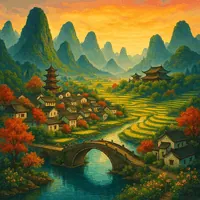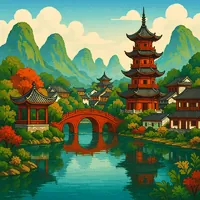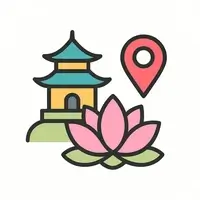


Bijie, China
Population: 6,899,636
Nestled in the mesmerizing karst landscape of Guizhou Province, Bijie stands out with its enchanting natural tapestry featuring the majestic Zhijin Cave, one of the world's largest and most awe-inspiring cave systems, adorned with limestone formations that seem sculpted by an artist's hand. Home to vibrant Miao and Yi cultures, Bijie uniquely blends traditional festivals like the lively Torch Festival with the innovative ecological initiative “Tiaolong Heqing,” transforming barren land into blossoming fields, showcasing humanity's harmonious potential with nature.













Notable points about Bijie
- Spectacular Karst Landscapes: Bijie is renowned for its dramatic karst topography, which creates stunning landscapes and unique geological formations, like the Zhijin Cave, often described as a natural wonder and one of the largest karst caves in the world.
- Biodiversity Hotspot: Nature enthusiasts will appreciate Bijie's location within the Wumeng Mountain region, which is home to a diverse range of flora and fauna, including rare species not found in other parts of China.
- Cultural Mosaic: This city is culturally rich, with a significant population of ethnic minorities, including the Miao and Yi communities, who contribute to the area's vibrant festivals and traditional arts, offering visitors a chance to experience genuine cultural diversity.
- Pleasant Climate: Unlike many other Chinese cities, Bijie enjoys a mild subtropical highland climate, providing cooler summers and comparatively warmer winters, making it a comfortable destination year-round, particularly appealing to retirees seeking a moderate climate.
- Emerging Economic Hub: Bijie is part of China's broader efforts to develop its western regions, with growing opportunities in sectors like energy and mining. This development brings in both job prospects and a distinct transformation that sets it apart from more developed eastern cities.
- Rich Agricultural Heritage: For those interested in agritourism, Bijie's fertile lands produce a variety of crops, including tea and tobacco, offering unique opportunities to explore rural life and engage with sustainable farming practices.
- Adventure Seeker's Paradise: Outdoor enthusiasts can indulge in a variety of activities such as hiking in the nearby mountains or exploring the city's pristine natural parks, providing escapes for singles and couples looking for adventure or tranquility.
- Less Commercialized Tourism: Unlike major Chinese tourist cities, Bijie offers a more authentic and less commercialized experience. Its tourism industry is still emerging, making it an ideal destination for travelers looking to explore off-the-beaten-path locations.
- Historical Significance: Bijie's history is marked by its role in the Long March, a key event in Chinese revolutionary history. History buffs can visit sites and monuments commemorating these historical events, providing a sense of the city's significant past contributions.
- Modern Infrastructure with a Local Touch: Despite its ongoing development, Bijie retains its local charm, unlike some rapidly modernizing cities in China. It offers modern facilities and amenities while preserving its traditional architecture and slower pace of life, a unique blend attractive to families seeking a balance between modernity and tradition.
Summarized Traveller Reviews
Bijie's Neighborhoods
Qixingguan District
🎯 Key Attractions
- Bijie Grand Theater: Hosts cultural performances and local arts showcases year-round.
- People's Square: An open-air plaza where families gather for evening strolls and community dance.
- The Whispering Pines Garden: A tranquil, pine-shaded park said to echo softly on windier days.
✨ Unique Aspects
Known for its civic architecture, late-night badminton games, and stalls that sell peanut-sesame pastries still warm from the griddle.
Zhijin Old Town
🎯 Key Attractions
- Zhijin Cave: One of China’s largest karst caves, with surreal stalactite formations.
- Old Town Market Street: A cobbled lane of red lanterns, sticky rice cakes, and tobacco shops.
- The Bone Bridge: A folk-believed crossing where travelers whisper wishes before dawn.
✨ Unique Aspects
“Every building has a story,” said Mr. Zhao, a third-generation tea vendor who still brews from spring water only.
Dafang Cultural Quarter
🎯 Key Attractions
- Bijie Minority Museum: Showcasing intricate Miao embroidery and Yi silver headdresses.
- Dafang Street Festival: Annual spring festival where drums, firecrackers, and dance fill the air.
- Lantern Weaver’s Courtyard: A tucked-away studio producing hand-dyed lanterns in ochre and indigo.
✨ Unique Aspects
“I came for the fabrics, but I stayed for the stories stitched into every thread.” – Elaine, traveler from Toronto
Bijie Economic Development Zone
🎯 Key Attractions
- Tech Pioneer Plaza: Innovation hub with co-working spaces and electric scooter charging stations.
- Huayu Shopping Complex: Trendy boutiques and Bijie’s first 5D cinema.
- Byte & Bean: A café where start-up founders meet over oolong-taro lattes.
✨ Unique Aspects
Feels like a city within a city—where you might overhear three languages at one lunch counter.
Hezhang Forest Edge
🎯 Key Attractions
- Hezhang Pine Park: Popular for early-morning tai chi and bird calls that sound like windchimes.
- Stone Lantern Trail: An old footpath once used by monks, now a locals' weekend escape.
- The Silver Kettle Teahouse: Serves smoked green tea in hand-poured clay cups under willow canopies.
✨ Unique Aspects
“There’s no rush here—just rhythm,” said Lin, who moved to escape Guiyang’s buzz.
Xingfa Night Market Area
🎯 Key Attractions
- Xingfa Night Market: Rows of food carts selling grilled tofu, fried milk, and spicy rabbit.
- Moonlit Arcade Row: Dozens of claw machines, VR pods, and nostalgic rhythm games.
- Lantern Alley: An alleyway with hanging paper lanterns and a fortune-cookie stall that actually bakes on-site.
✨ Unique Aspects
“I didn’t expect to salsa until 3AM with strangers—and love it.” – Chloe, traveler from Melbourne
Jinhai Lakeside
🎯 Key Attractions
- Jinhai Park: Cycling paths and floating lotus blooms in spring.
- Wind Pavilion Dock: A pier where elderly locals play chess and hum old folk songs.
- Whistling Duck Café: Famous for jasmine rice porridge and quiet balcony seating.
✨ Unique Aspects
“This is where time moves like mist across the lake—unhurried, gentle.” – Dev, writer from Mumbai
Yongping Heritage Quarter
🎯 Key Attractions
- Yongping Temple: A historic Buddhist temple with hand-carved wooden beams and incense-lined halls.
- Folk Art Gallery: Showcases traditional masks, calligraphy, and paper-cutting demos.
- The Monk’s Courtyard Bakery: Hidden bakery rumored to use recipes over 200 years old.
✨ Unique Aspects
The streets smell faintly of sandalwood, and locals nod in greeting even if you’re just passing through.
Qianxi Valley View
🎯 Key Attractions
- Qianxi Scenic Overlook: Panoramic views of layered mountains and patchwork farmlands.
- Winding Bellflower Road: Named after the wild bellflowers that bloom in April.
- Driftwood Library Café: A hillside reading nook with wooden interiors and no Wi-Fi.
✨ Unique Aspects
“Best view in Bijie, hands down. Bring a scarf, and a book you don’t mind rereading.” – Hana, nomad from Seoul
Baiyun Art Blocks
🎯 Key Attractions
- Baiyun Graffiti Corridor: An alley now famous for massive mural collaborations.
- Studio Collective 32: A shared workspace for painters, sculptors, and digital artists.
- The Ceramic Cow: Coffee shop doubling as an open-mic venue and gallery space.
✨ Unique Aspects
Feels like an idea incubator with paint-streaked jeans and laughter echoing from a second-story window.




































































































